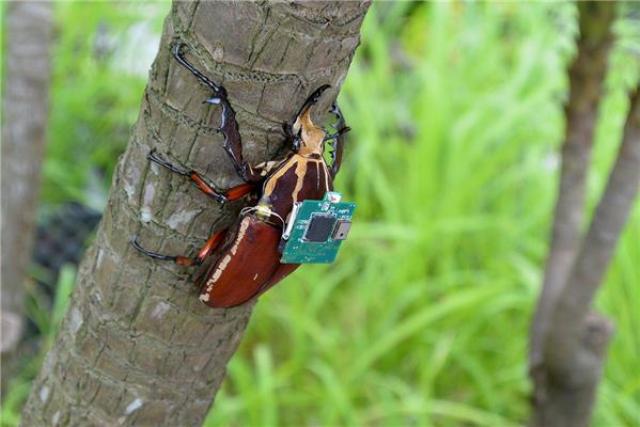Mar 20 2015
Giant beetles potential alternative to remote-controlled drones
Breaking new grounds in the future of remote-controlled drone technology, Nanyang Technological University (NTU Singapore) and the University of California (UC) Berkeley, has jointly developed a living machine whose flight can be wirelessly controlled with minimal human intervention.
 Developed by NTU and UC Berkeley using cost effective electronics, giant beetles could be a potential alternative to remote-controlled drones
Developed by NTU and UC Berkeley using cost effective electronics, giant beetles could be a potential alternative to remote-controlled drones
Mounted on top of a giant flower beetle, a tiny, electronic backpack with a built-in wireless receiver and transmitter converts radio signals received remotely into a variety of actions in the beetle.
Signals were transmitted to the beetle high-tech backpack every millisecond, directing the beetles to take off, turn left or right, or even hover in mid-flight. The beetles were untethered but flew within a closed room equipped with eight 3-D motion capture cameras to capture movement data.
Unlike typical remote-controlled synthetic drones, there is no need for constant human control as the beetle is able to maintain flight stability on its own. Human intervention is only needed to change the intended direction.
The beetle will then take care of the rest of journey, manoeuvring around obstacles and crawling into small confined spaces, up to 100 metres.
The joint NTU-UC Berkeley study was published on March 16 in Current Biology, a leading peer-reviewed journal that showcases top biomedical research.
The study was also picked as one of the journal’s best research discoveries, which made the cover of the month’s publication.
The project is led by Assistant Professor Hirotaka Sato from the NTU Singapore's School of Mechanical and Aerospace Engineering. “By sending a signal to the beetle, we are able to simply change its direction of movement and the beetle will manage the rest.
“This technology could prove to be an improved alternative to remote-controlled drones as it could go into areas which are not accessible before. For example, it could be used in search-and-rescue missions as it could go into small nooks and crevices in a collapsed building to locate injured survivors,” said Prof Sato, the lead author of the study.
Michel Maharbiz, associate professor at UC Berkeley's Department of Electrical Engineering and Computer Sciences said, “Our long term vision is to show that we can remotely induce an insect to fly, control its turns when required, and then stop it when the insect reached a set location – all done repeatedly and reliably.”
The giant flower beetle, scientifically known as ‘Mecynorrhina torquata’, averaged about 6 centimetres in length and 8 grams in weight, about as heavy as two Singapore $1 coin. Despite its size, it could lift relatively heavy payloads such as a small microphone and thermal sensor, crucial for search-and-rescue missions.
Cost-effective microelectronics
The materials used to build the high-tech backpack cost less than S$10, and the electronics are easy to build with mostly off-the-shelf components.
It is operated by a microprocessor, which not only combines thousands of transistors onto a 1-cm square chip, but comes with a built-in wireless receiver.
The microchip is strapped onto the beetle using organic beeswax, which is harmless to the beetle’s carapace and could be easily removed.
Six electrodes from the microprocessor are connected to the beetle’s optic lobes and flight muscles. Signals received wirelessly influence the insect to take off, turn left or right, or even hover in mid-flight.
Although the entire setup is powered by a 3.9 volt micro lithium battery, which provides more than enough power to last an entire day, it would one day operate without it.
“In the future, the overall rig may not even use batteries. It could be powered from sustainable sources such as energy scavenged from ambient radio waves,” said Prof Sato, who is a recipient of NTU Singapore’s prestigious Nanyang Assistant Professorship award which recognises exceptional young academics with research grants up to $1 million.
The detachable high-tech backpack is harmless to the beetle. The giant insect goes on to live normally and fulfils its regular, adult lifespan which is about five to six months.
New finding could lead to improved control
For over 200 years, biologists believed that a particular muscle located in between the beetle’s wings – known as the coleopteran muscle – was solely responsible for controlling the folding of wings.
However, the joint NTU-UC Berkeley research project also discovered that this muscle played a part in controlling the beetle’s steering or turning ability.
“Since the 1800s, the beetle’s coleopteran muscle was thought to function solely in wing folding,” said Prof Sato. “Our wireless system allows us to record neuro-muscular movements in natural, free flight and by doing so, we found out that this muscle is also used for steering and turning."
The new finding thus highlighted the potential for further research to improve the precision of the beetles’ remote-controlled turns, said Prof Sato.
The NTU-UC Berkeley research project was supported by NTU Singapore, the Agency for Science, Technology and Research in Singapore (A*STAR) and the National Science Foundation in the United States.
Source: http://www.ntu.edu.sg/